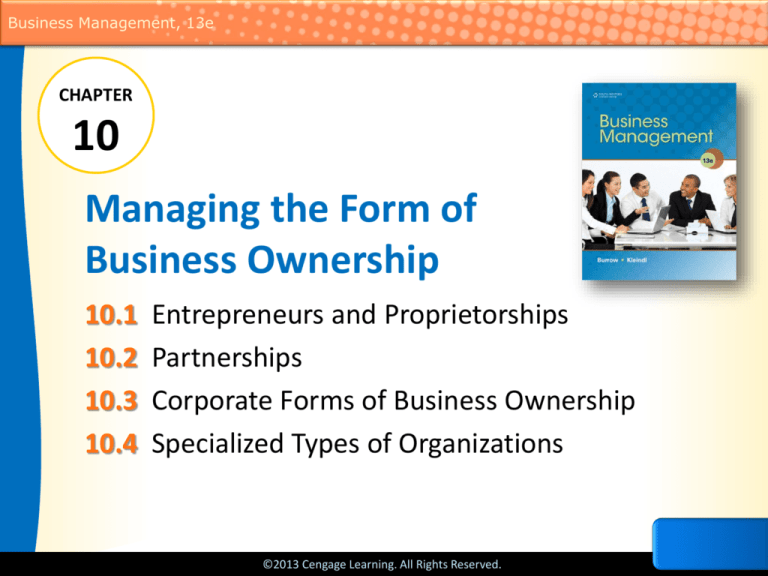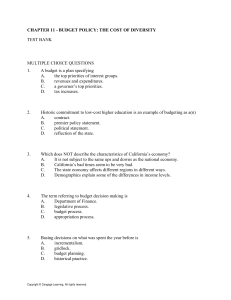
Business Management, 13e
CHAPTER
10
Managing the Form of
Business Ownership
10.1
10.2
10.3
10.4
Entrepreneurs and Proprietorships
Partnerships
Corporate Forms of Business Ownership
Specialized Types of Organizations
©2013 Cengage Learning. All Rights Reserved.
Business Management, 13e
2
10.1 Entrepreneurs and
Proprietorships
GOALS
● Describe the characteristics of successful
entrepreneurs.
● Evaluate the role of planning in managing your
own business.
● Explain the management issues of
proprietorships.
CHAPTER 10
©2013 Cengage Learning. All Rights Reserved.
Business Management, 13e
3
Characteristics of Entrepreneurs
● Entrepreneurs
● A person who assumes risk of starting, owning, and
operating a business for the purpose of making profit.
● Self starters who have plenty of energy and enjoy
working on their own
● Intrapreneurs
● An employee who is given funds and freedom to
create a special unit or department within a company
to develop a new product, process, service.
CHAPTER 10
©2013 Cengage Learning. All Rights Reserved.
Business Management, 13e
4
Checkpoint
● Explain why businesses start-ups often fail?
CHAPTER 10
©2013 Cengage Learning. All Rights Reserved.
Business Management, 13e
5
Checkpoint
● Explain why businesses start-ups often fail?
● Financial reasons
● Owners are not suited to entrepreneurship
CHAPTER 10
©2013 Cengage Learning. All Rights Reserved.
Business Management, 13e
6
Planning a Business
● Business plan
● Describes nature of the business, goals and
objectives, and how it will achieve them.
● Forms of ownership
● Proprietorships
● Partnerships
● Corporations
CHAPTER 10
©2013 Cengage Learning. All Rights Reserved.
Business Management, 13e
7
Checkpoint
● Describe two advantages of developing a
business plan?
CHAPTER 10
©2013 Cengage Learning. All Rights Reserved.
Business Management, 13e
8
Checkpoint
● Describe two advantages of developing a
business plan?
● Identify the risks and responsibilities of owning a
business
● Inspire confidence in potential investors
● Identify problems
● Help entrepreneurs become more realistic
CHAPTER 10
©2013 Cengage Learning. All Rights Reserved.
Business Management, 13e
9
The Nature of Proprietorships
● A Business owned and managed by one person
● Proprietor
● Creditor – person or business to which money is owed
● Management issues of proprietorships
● Self management
● Relationship management
● Speed of decision making
● Freedom from red tape
● Liability
CHAPTER 10
©2013 Cengage Learning. All Rights Reserved.
Business Management, 13e
10
The Nature of Proprietorships
● Businesses suited to proprietorship
● Small enough to be managed by the proprietor or
a few people hired by the proprietor
● Does not require a large amount of capital
● Part-time proprietorships
● 1/3 of proprietorships are part time
CHAPTER 10
©2013 Cengage Learning. All Rights Reserved.
Business Management, 13e
11
© Cengage Learning 2013.
Balance Sheet for Proprietorship
CHAPTER 10
©2013 Cengage Learning. All Rights Reserved.
Business Management, 13e
12
Checkpoint
● List the management issues related to sole
proprietorships?
CHAPTER 10
©2013 Cengage Learning. All Rights Reserved.
Business Management, 13e
13
Checkpoint
● List the management issues related to sole
proprietorships?
● Self management
● Speed of decision making
● Relationship management
● Freedom from red tape
● Liability
CHAPTER 10
©2013 Cengage Learning. All Rights Reserved.
Business Management, 13e
14
10.2 Partnerships
GOALS
● Discuss the impact of partnerships on
managing a business.
● Explain the management issues of
partnerships.
CHAPTER 10
©2013 Cengage Learning. All Rights Reserved.
Business Management, 13e
15
The Nature of Partnerships
● Partnership—a business owned by two or
more people.
● Partnership agreement—a written agreement
between two or more people identifying how
the partners will add capital, labor, or other
assets and divide any profits
CHAPTER 10
©2013 Cengage Learning. All Rights Reserved.
Business Management, 13e
16
Checkpoint
● What are some reasons for considering
forming a partnership?
CHAPTER 10
©2013 Cengage Learning. All Rights Reserved.
Business Management, 13e
17
Checkpoint
● What are some reasons for considering
forming a partnership?
● A partnership can allow for shared responsibility
● Additional capital
● More management expertise
CHAPTER 10
©2013 Cengage Learning. All Rights Reserved.
Business Management, 13e
18
Management Issues of Partnerships
● Expanded management input
● Capital
● Efficiency
● Tax advantages
● Liability
● Agreement between partners
● Uncertain life
● Division of profits
CHAPTER 10
©2013 Cengage Learning. All Rights Reserved.
Business Management, 13e
19
Limited Partnerships
● Limited partnership—partnership with at least
one general partner who has unlimited
liability and at least one limited partner whose
liability is limited to his or her investment.
CHAPTER 10
©2013 Cengage Learning. All Rights Reserved.
Business Management, 13e
20
Businesses Suited to Partnership
● More than one kind of product or service
● More than one location
● Extended operating hours
● Professional services
CHAPTER 10
©2013 Cengage Learning. All Rights Reserved.
Business Management, 13e
21
© Cengage Learning 2013.
© Cengage Learning 2013.
Balance Sheets for Proprietorships
CHAPTER 10
©2013 Cengage Learning. All Rights Reserved.
Business Management, 13e
22
© Cengage Learning 2013.
Balance Sheet for a Partnership
CHAPTER 10
©2013 Cengage Learning. All Rights Reserved.
Business Management, 13e
23
Checkpoint
● What are the disadvantages of a partnership?
CHAPTER 10
©2013 Cengage Learning. All Rights Reserved.
Business Management, 13e
24
Checkpoint
● What are the disadvantages of a partnership?
● Unlimited financial liability
● Partnership disagreement
● Partners bound by contracts
● Uncertain life of business
● Limited sources of capital
● Unsatisfactory divisions of profits
● Difficulty withdrawing from partnership
CHAPTER 10
©2013 Cengage Learning. All Rights Reserved.
Business Management, 13e
25
10.3 Corporate Forms of Business
Ownership
GOALS
● Explain the basic structure of a corporation.
● Describe how a corporation is formed and
organized.
● Explain the management issues of
corporations.
CHAPTER 10
©2013 Cengage Learning. All Rights Reserved.
Business Management, 13e
26
The Structure of Corporations
● Basic features
● Stockholders
● Directors
● Officers
● Charter (Certificate of incorporation)
● Close and open corporations
● Does not offer shares of stock to public
● Offers shares of stock to public
CHAPTER 10
©2013 Cengage Learning. All Rights Reserved.
Business Management, 13e
27
Checkpoint
● List the three key groups of a corporation?
CHAPTER 10
©2013 Cengage Learning. All Rights Reserved.
Business Management, 13e
28
Checkpoint
● List the three key groups of a corporation?
● Stockholders
● Directors
● Officers
CHAPTER 10
©2013 Cengage Learning. All Rights Reserved.
Business Management, 13e
29
Formation of Corporations
● Preparing the certificate of incorporation
● Stating the purpose of the business
● Investing in the business
● Paying incorporation costs
● Operating the new corporation
● Getting organized
● Handling voting rights
CHAPTER 10
©2013 Cengage Learning. All Rights Reserved.
Business Management, 13e
30
Organization Chart for a Corporation
CHAPTER 10
©2013 Cengage Learning. All Rights Reserved.
Business Management, 13e
31
Management Issues for Corporations
●
●
●
●
●
●
●
●
●
Sources of capital
Limited liability
Permanency of existence
Ease in transferring ownership
Taxation
Government regulations and reports
Stockholders’ records
Charter restrictions
Agency dilemma
CHAPTER 10
©2013 Cengage Learning. All Rights Reserved.
Business Management, 13e
32
© Cengage Learning 2013.
Balance Sheet for a Corporation
CHAPTER 10
©2013 Cengage Learning. All Rights Reserved.
Business Management, 13e
33
Checkpoint
● What are the disadvantages of the corporate
form of ownership?
CHAPTER 10
©2013 Cengage Learning. All Rights Reserved.
Business Management, 13e
34
Checkpoint
● What are the disadvantages of the corporate
form of ownership?
● Taxed twice
● Comply with strict government regulations
● Maintain records
● Charters restrict their activities
CHAPTER 10
©2013 Cengage Learning. All Rights Reserved.
Business Management, 13e
35
10.4 Specialized Types of
Organizations
GOALS
● Describe organizations that are specialized
alliances between companies or individuals.
● Describe specialized forms of corporations
formed for tax or nonprofit reasons.
CHAPTER 10
©2013 Cengage Learning. All Rights Reserved.
Business Management, 13e
36
Organizational Alliances
● Limited liability partnerships (LLP)
● Partners liability is limited to his or her investment in
the partnership
● Accounting Firms, legal firms
● Joint ventures
● An agreement among two or more business to work
together to provide a good or service
● Two contractors to connect two cities by building a
tunnel
● Cooperative
● Popular in agriculture for buying and selling crops
CHAPTER 10
©2013 Cengage Learning. All Rights Reserved.
Business Management, 13e
37
Checkpoint
● Describe the difference between the three
types of organizational alliances?
CHAPTER 10
©2013 Cengage Learning. All Rights Reserved.
Business Management, 13e
38
Checkpoint
● Describe the difference between the three
types of organizational alliances?
● LLPs has limited liabilities
● JVs are an agreement between two or more
businesses to work together
● Cooperatives are businesses owned by usermembers
CHAPTER 10
©2013 Cengage Learning. All Rights Reserved.
Business Management, 13e
39
Specialized Forms of Corporations
● Limited liability company (LLC)
● Taxed as if it was a proprietorship or partnership
● Supchapter S
● Nonprofit corporations
● Does not pay taxes
● Does not make a profit
● Quasi-public corporations
● Important to society but lacks profit potential to
attract private investors operated by government
CHAPTER 10
©2013 Cengage Learning. All Rights Reserved.
Business Management, 13e
40
Checkpoint
● What is the main advantage of choosing an
LLC or Supchapter S status?
CHAPTER 10
©2013 Cengage Learning. All Rights Reserved.
Business Management, 13e
41
Checkpoint
● What is the main advantage of choosing an
LLC or Supchapter S status?
● These forms have limited liability and but are
taxed like a partnership.
CHAPTER 10
©2013 Cengage Learning. All Rights Reserved.






